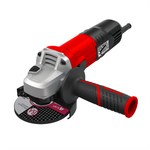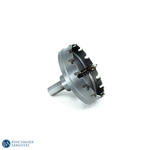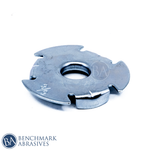
Types of Concrete Saw Blades

A concrete saw is a potential tool for cutting concrete, bricks, asphalt, and other solid materials. It is frequently called a Consaw or road saw. Concrete saw blades are diamond-tipped due to their fast cutting of hard materials. Concrete saws are more efficient than conventional saws.
The construction sector depends on concrete saw blades, which are regularly and effectively used to cut masonry, including concrete.
Many kinds of concrete saw blades are on the market right now. The depth at which you cut the concrete determines the blade to use. All concrete cutters serve the same function, while others are more durable and reliable than others for quality work.
In this article, we’ll discuss different types of concrete saw blades. Additionally, you will learn about the various concrete sawing techniques here.
Methods of Sawing Concrete
Sawing can be done in two separate ways, which are Dry Sawing and Wet Sawing.
Dry Concrete Sawing
For outdoor projects, the dry concrete sawing method is better as it creates a lot of dust on the sawing site. If the saw’s blade consists of a diamond, it can be kept cold without water.
A diamond blade can help decrease dust build-up. This technique involves making brisk cuts that are very small and progressively deeper to avoid the edge from heating.
Wet Concrete Sawing
Wet concrete sawing is good for the environment and for the workers' health. Because of the moisture in the concrete, it produces less dust.
The water in the wet sawing keeps the blade self-lubricating and cool, increasing its lifespan.
6 Types of Concrete Saw Blades

Depending on the purpose, many types of concrete saw blades are used to cut concrete. There are six common forms of commonly used blades.
1. Corundum Masonry Blade
Corundum masonry blades are used for short and shallow cutting. Concrete is a hard material to cut, which is why the edges of masonry don't last long. They quickly wear off or crack.
Although they may be inexpensive, the Corundum Masonry Blades require more effort. When cutting, masonry blades create a lot of dust, which heats the edges. Their primary use is for shallow cuts.
2. Diamond Blades
Diamond blades are the most often used concrete saw blades for both dry and wet sawing. They work best when cutting concrete. The diamonds are set into a steel disc with a rim on these blades.
BEST 14-INCH DIAMOND BLADE FOR CONCRETE
The sides of diamond blades are made of metal and diamond composite. Diamond blades make longer and deeper cuts. When used for dry cutting, their serrated edges help to keep the blade cool while cutting. However, they produce a lot of dust.
Different types of diamond blades are available to provide you with the cleanest and fastest cuts.
3. Turbo-Rim Blade
Turbo rim blades are the traditional blades used to cut concrete. Because of their serrated rim, these blades cut through strong, rough materials like bricks and concrete.
Most professionals prefer this special concrete cutting blade primarily because it is more powerful than other continuous rim blade manufacturers. However, the turbo-rim blade does not leave a smooth finish due to the serrated rim, despite its dependability while cutting concrete.
4. Segmented Blades
Segmented blades cut concrete through their diamond edges. This particular blade is built with a rim that uses gullets to break. Due to their segments, segmented blades are considered more straightforward to use and healthier.
Additionally, compared to other blades made specifically for cutting concrete, these segments frequently enable the blade to cut more swiftly. You may use this same blade to cut other rigid materials, such as bricks and concrete.
5. Abrasive Blades
Another common type of concrete saw blade is an abrasive blade. Abrasive blades are also used to cut several rigid materials, such as bricks and even metal.
Abrasive blades are different from other types of concrete cutting blades in that they lack segments and edges. They are used to cut harder materials with an abrasive substance like silicon carbide or aluminum oxide.
6. Circular Saw Blade
Concrete, bricks, and other hard materials can be sliced with circular saw blades that have diamond or abrasive blades.
However, before you start cutting, you must set the depth of the circular saw. A circular saw can slice concrete efficiently and smoothly.
What is the Best Blade for Cutting Concrete?
Diamond saw blades are the finest option for cutting concrete. They are the ideal blades for breaking asphalt and concrete and creating expert, smooth cuts. However, this group offers unlimited blade options in different price ranges.
You need a soft, bonded diamond blade of concrete when you cut hard things. You need a hard-bonded diamond blade when you cut soft material like asphalt.
Whether cutting through old concrete for repair or rebuilding, enhancing concrete with finish grading, or cutting control joints, your cutting won't be perfect without a good saw blade.
It is impossible to rely on a single blade type to accomplish all cutting operations accurately or to carry out the same function across many concrete blade types.
Tips For Using Concrete Saw Blades
Following are some of valuable tips for using concrete saw blades:
-
Begin slow: It's essential to start slow when using saw blades to ensure safety and avoid accidents. If you are using a new blade, it usually has a protective coating that needs to be removed before it reaches its maximum cutting speed. Begin slowly, which will help you get to that level by eliminating that layer and providing the sharp diamond segments. Starting slowly also helps prevent the blades from overheating and offers efficient material removal from concrete and other materials.
-
Safety: always wear protective gear to protect yourself from dust, sparks, and other flying objects. Protective gears include hand gloves, face masks and shields, respirators, ear protection, etc.
-
Right storage: Ensure you store your blades in a safe and appropriate location to avoid rust, corrosion, or other damage.
-
Regular examination: Examine the saw blades to avoid accidents during the cutting process. Check for any wear and tear and replace it immediately.
- Alternative cutting: If you only have an angle grinder, you can still cut concrete using a diamond blade, but it’s best suited for small, shallow cuts rather than heavy-duty projects. Always control dust with water and wear full protective gear.



































































